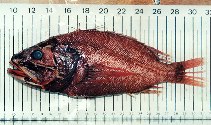| Family: |
Setarchidae (Deep-sea bristly scorpionfishes) |
| Max. size: |
18 cm SL (male/unsexed) |
| Environment: |
bathypelagic; marine; depth range 150 - 2000 m |
| Distribution: |
Atlantic, Indian and Pacific: in tropical and temperate waters. Eastern Atlantic: tropical western Africa. Western Atlantic: Canada (Ref. 5951) to Gulf of Mexico to Suriname. |
| Diagnosis: |
Dorsal spines (total): 11-12; Dorsal soft rays (total): 9-11; Anal spines: 3-3; Anal soft rays: 5-7. Swim bladder lacking or rudimentary; bones poorly ossified; spine weak and usually broken during capture; scales thin and deciduous, and white body musculature soft and flabby (Ref. 11015). Lateral line more or less a continuous trough covered by thin membranous scales, usually lost during capture (Ref. 10482). Body is black in small specimens; maroon and black in adults (Ref. 11015). Buccal cavity black with patches of bright orange and red in life; pharyngeal teeth red or orange (Ref. 11015). |
| Biology: |
Among all scorpionfishes, it is structurally best adapted for mid-water existence (Ref. 11015). Benthopelagic (Ref. 58302). Feeds mainly on crustaceans, amphipods and sergestid shrimps (Ref. 28023). Anterolateral glandular grooves with venom gland at least in anal-fin spines (Ref. 57406). |
| IUCN Red List Status: |
Least Concern (LC); Date assessed: 15 July 2013 Ref. (130435)
|
| Threat to humans: |
venomous |
| Country info: |
One specimen (12.5 cm SL) caught by an otter trawl in 892-966 m (Ref. 95664). |
Source and more info: www.fishbase.org. For personal, classroom, and other internal use only. Not for publication.

